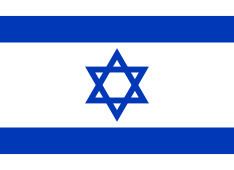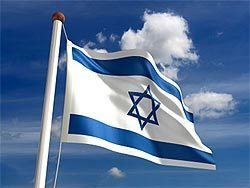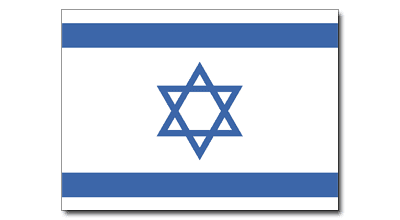Use National flag Proportion 2:3 | Adopted on 28 October 1948 Country Israel | |
Design A blue Star of David between two horizontal blue stripes on a white field. Design Navy blue flag with a white vertically elongated oval set near the hoist containing a vertically elongated blue Star of David. Design Navy blue flag with a white triangle at hoist and blue Star of David in it. Design Light blue flag with thin white stripes with dark blue borders near the top and bottom, displaying an air force roundel in the center. | ||
Israelis what do the symbols on the flag of israel mean
The flag of Israel (Hebrew: דגל ישראל Degel Yisra'el, Arabic: علم إسرائيل 'Alam Isra'īl) was adopted on October 28, 1948, five months after the establishment of the State of Israel. It depicts a blue hexagram on a white background, between two horizontal blue stripes.
Contents
- Israelis what do the symbols on the flag of israel mean
- Flag of israel
- Origin of the flag
- From Israeli Arabs
- From Ultra Orthodox Jews
- Nile to Euphrates conspiracy
- Famous Israeli flags
- References

The blue colour is described as "dark sky-blue", and varies from flag to flag, ranging from a hue of pure blue, sometimes shaded almost as dark as navy blue, to hues about 75% toward pure cyan and shades as light as very light blue. The flag was designed for the Zionist Movement in 1891. The basic design recalls the Tallit, the Jewish prayer shawl, which is white with black or blue stripes. The symbol in the center represents the Star of David ("Magen David"), a Jewish symbol dating from late medieval Prague, which was adopted by the First Zionist Congress in 1897.

In 2007, an Israeli flag measuring 660 m × 100 m (2,170 ft × 330 ft) and weighing 5.2 tonnes (5.7 short tons) was unfurled near the ancient Jewish fortress of Masada, breaking the world record for the largest flag.

Flag of israel
Origin of the flag

The blue stripes are intended to symbolize the stripes on a tallit, the traditional Jewish prayer shawl. The portrayal of a Star of David on the flag of the State of Israel is a widely acknowledged symbol of the Jewish people and of Judaism.
The Israelites used a blue colored dye called tekhelet; this dye may have been made from the marine snail Murex trunculus. This dye was very important in both Jewish and non-Jewish cultures of this time, and was used by royalty and the upper class in dyeing their clothing, sheets, curtains, etc. (The dye from a related snail can be processed to form Tyrian purple called argaman.)
In the Bible, the Israelites are commanded to have one of the threads of their tassels (tzitzit) dyed with tekhelet; "so that they may look upon it, and remember all the commandments of the LORD, and do them (Num 15:39)." Tekhelet corresponds to the colour of the divine revelation (Midrash Numbers Rabbah xv.). Sometime near the end of the Talmudic era (500–600 CE) the industry that produced this dye collapsed. It became more rare; over time, the Jewish community lost the tradition of which species of shellfish produced this dye. Since Jews were then unable to fulfil this commandment, they have since left their tzitzit (tallit strings) white. However, in remembrance of the commandment to use the tekhelet dye, it became common for Jews to have blue or purple stripes woven into the cloth of their tallit.
The idea that the blue and white colours were the national colour of the Jewish people was voiced early on by Ludwig August Frankl (1810–1894), an Austrian Jewish poet. In his poem, "Judah's Colours", he writes:
When sublime feelings his heart fill, he is mantled in the colors of his country. He stands in prayer, wrapped in a sparkling robe of white.
The hems of the white robe are crowned with broad stripes of blue; Like the robe of the High Priest, adorned with bands of blue threads.
These are the colours of the beloved country, blue and white are the colours of Judah; White is the radiance of the priesthood, and blue, the splendors of the firmament.
In 1885, the agricultural village of Rishon LeZion used a blue and white flag designed by Israel Belkind and Fanny Abramovitch in a procession marking its third anniversary. In 1891, Michael Halperin, one of the founders of the agricultural village Nachalat Reuven flew a similar blue and white flag with a blue hexagram and the text "נס ציונה" (Nes Ziona, "a banner for Zion": a reference to Jeremiah 4:6, later adopted as the modern name of the city). A blue and white flag, with a Star of David and the Hebrew word "Maccabee", was used in 1891 by the Bnai Zion Educational Society. Jacob Baruch Askowith (1844–1908) and his son Charles Askowith designed the "flag of Judah," which was displayed on July 24, 1891, at the dedication of Zion Hall of the B'nai Zion Educational Society in Boston, Massachusetts, U.S. Based on the traditional tallit, or Jewish prayer shawl, that flag was white with narrow blue stripes near the edges and bore in the center the ancient six-pointed Shield of David with the word "Maccabee" in gilt letters.
In Herzl's 1896 Der Judenstaat, he stated:
Wir haben keine Fahne. Wir brauchen eine. Wenn man viele Menschen führen will, muss man ein Symbol über ihre Häupter erheben. Ich denke mir eine weisse Fahne, mit sieben goldenen Sternen. Das weisse Feld bedeutet das neue, reine Leben; die Sterne sind die sieben goldenen Stunden unseres Arbeitstages. Denn im Zeichen der Arbeit gehen die Juden in das neue Land.
We have no flag, and we need one. If we desire to lead many men, we must raise a symbol above their heads. I would suggest a white flag, with seven golden stars. The white field symbolizes our pure new life; the stars are the seven golden hours of our working-day. For we shall march into the Promised Land carrying the badge of honor.
David Wolffsohn (1856–1914), a businessman prominent in the early Zionist movement, was aware that the nascent Zionist movement had no official flag, and that the design proposed by Theodor Herzl was gaining no significant support, wrote:
At the behest of our leader Herzl, I came to Basle to make preparations for the Zionist Congress. Among many other problems that occupied me then was one that contained something of the essence of the Jewish problem. What flag would we hang in the Congress Hall? Then an idea struck me. We have a flag—and it is blue and white. The talith (prayer shawl) with which we wrap ourselves when we pray: that is our symbol. Let us take this Talith from its bag and unroll it before the eyes of Israel and the eyes of all nations. So I ordered a blue and white flag with the Shield of David painted upon it. That is how the national flag, that flew over Congress Hall, came into being.
While this flag emphasizes Jewish religious symbols, Theodor Herzl wanted the flag to have more universal symbols: 7 golden stars symbolizing the 7-hour working quota of the enlightened state-to-be, which would have advanced socialist legislations.
In 1897, the First Zionist Congress was held in Basel, Switzerland, to consider re-establishing a homeland for Jews in Palestine. Morris Harris, a member of New York Hovevei Zion, used his awning shop to design a suitable banner and decorations for the reception, and his mother Lena Harris sewed the flag. The flag was made with two blue stripes and a large blue Star of David in the center, the colours blue and white chosen from the design of the tallit. The flag was ten feet by six feet—in the same proportions as the flag of the United States—and became known as the Flag of Zion. It was accepted as the official Zionist flag at the Second Zionist Congress held in Switzerland in 1898, and the State of Israel later adopted the design as the official flag, upon declaration of Israel as an independent state in 1948.
A flag with blue and white stripes and a Magen David in the center flew with those of other nationalities from one of the buildings at the Louisiana Purchase Exposition of 1904. It flew there in relation to large meetings of Zionists. That expo was the World's Fair hosting the 1904 Summer Olympics.
From Israeli Arabs
Some Israeli Arab politicians, as well as the High Follow-Up Committee for Arab Citizens of Israel have requested a re-evaluation of the Israeli flag, arguing that the Star of David at the flag's centre is an exclusively Jewish symbol.
However, many other nations have religiously exclusive symbols on their flags as well. For example, Muslim symbols are on the flags of Algeria, Turkey, and Pakistan, and Christian symbols are on the flags of the Nordic countries, Switzerland, and the United Kingdom.
In addition, the Star of David (or Shield of David) was not historically an exclusively Jewish symbol. It was used as an architectural motif inconsistently in ancient synagogues, and it notably appears on the cover page of the Leningrad Codex. It became an important Jewish symbol in the early Middle Ages. In medieval times, this star was also an Islamic symbol known as the Seal of Solomon (Suleiman) and was also extremely popular among the Anatolian beyliks. States known to use the seal on their flags were the Karamanids and Jandarids. The seal was also used by Ottomans in their mosque decorations, coins and personal flags of pashas, including that of Hayreddin Barbarossa, as well as in Christian architecture such as the Basilica of Santa Croce, Florence.
From Ultra-Orthodox Jews
The Hasidim in particular were vociferous in their opposition to early Zionism and often protested against the Zionists. They even went as far as banning the Star of David, originally a religious symbol appearing only in the synagogue, which had now become "defiled" by the Zionists. Rabbi Moses Feinstein called the Israeli flag "a foolish and meaningless object" and discouraged its display in synagogues. The Chazon Ish wrote that praying in a synagogue decorated with an Israeli flag should be avoided even if there was no other synagogue in the area. Former Sephardic Chief Rabbi of Israel, Ovadia Yosef, also forbade the flying of the Israeli flag in synagogues, calling it "a reminder of the acts of the evil-doers." Rabbi Joel Teitelbaum referred to the flag as the "flag of heresy" and viewed it as an object of idol worship. Ultra-Orthodox Jews in Israel never display the Israeli flag and there are some fringe groups who resort to burning it on Israel’s independence day.
"Nile to Euphrates" conspiracy
It is a popular conspiracy theory in the Arab World that the blue stripes on the Israeli flag actually represent the rivers Nile and Euphrates as the boundaries of Eretz Yisra'el, the land promised to the Jews by God according to the Bible. Those making this allegation insist that the flag "secretly" represents the desire of Jews to conquer all of the land between the Nile and Euphrates rivers, which would involve conquering and ruling over much of Egypt, all of Jordan, most of Syria, and part of Iraq. Yasser Arafat, Iran and Hamas also made the allegation, and repeatedly tied this notion to the stripes on the Israeli flag.
Both Zionist and anti-Zionist authors have debunked the claim that the stripes on the flag represent territorial ambitions. Daniel Pipes notes "In fact, the blue lines derive from the design on the traditional Jewish prayer shawl", and Danny Rubinstein points out that "Arafat ... added, in interviews that he gave in the past, that the two blue stripes on the Israeli flag represent the Nile and the Euphrates .... No Israeli, even those who demonstrate understanding for Palestinian distress, will accept the ... nonsense about the blue stripes on the flag, which was designed according to the colours of the traditional tallit (prayer shawl)". Persistent critic of Israel and Zionism Israel Shahak is equally explicit. In his The Zionist Plan for the Middle East he states:
...the persistent, and completely false declarations, which were made by some of the most important Arab leaders, that the two blue stripes of the Israeli flag symbolize the Nile and the Euphrates, while in fact they are taken from the stripes of the Jewish praying shawl (Talit).
Saqr Abu Fakhr, an Arab writer, has also spoken out against this idea. He writes that the "Nile to Euphrates" claim regarding the flag is one of seven popular misconceptions and/or myths about Jews which, despite being unfounded and having abundant evidence refuting them, continue to circulate in the Arab world.
Nevertheless, the Hamas Covenant states "After Palestine, the Zionists aspire to expand from the Nile to the Euphrates," and as recently as January 29, 2006, Hamas leader Mahmoud al-Zahar issued a demand for Israel to change its flag, citing the "Nile to Euphrates" argument.
